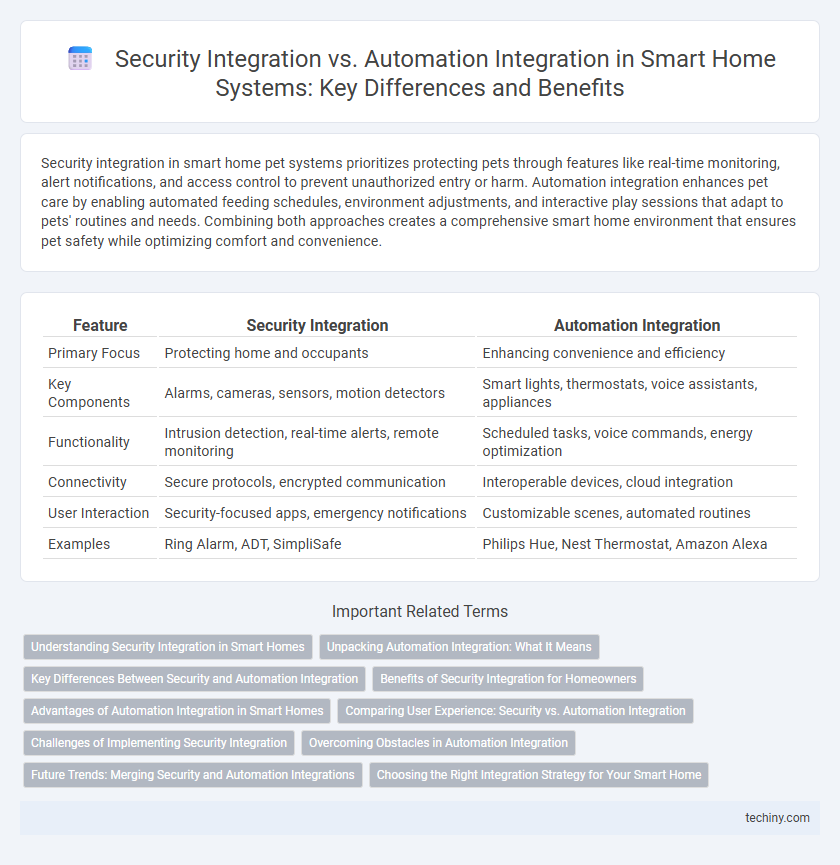Security integration in smart home pet systems prioritizes protecting pets through features like real-time monitoring, alert notifications, and access control to prevent unauthorized entry or harm. Automation integration enhances pet care by enabling automated feeding schedules, environment adjustments, and interactive play sessions that adapt to pets' routines and needs. Combining both approaches creates a comprehensive smart home environment that ensures pet safety while optimizing comfort and convenience.
Table of Comparison
| Feature | Security Integration | Automation Integration |
|---|---|---|
| Primary Focus | Protecting home and occupants | Enhancing convenience and efficiency |
| Key Components | Alarms, cameras, sensors, motion detectors | Smart lights, thermostats, voice assistants, appliances |
| Functionality | Intrusion detection, real-time alerts, remote monitoring | Scheduled tasks, voice commands, energy optimization |
| Connectivity | Secure protocols, encrypted communication | Interoperable devices, cloud integration |
| User Interaction | Security-focused apps, emergency notifications | Customizable scenes, automated routines |
| Examples | Ring Alarm, ADT, SimpliSafe | Philips Hue, Nest Thermostat, Amazon Alexa |
Understanding Security Integration in Smart Homes
Security integration in smart homes involves connecting surveillance cameras, motion sensors, door locks, and alarm systems to a centralized platform for real-time monitoring and threat detection. This integration enhances homeowner safety by allowing remote access, instant alerts, and automated responses to security breaches. Unlike automation integration, which focuses on convenience and efficiency, security integration prioritizes protection and proactive risk mitigation.
Unpacking Automation Integration: What It Means
Automation integration in smart homes refers to the seamless connection of devices and systems to enable centralized control and intelligent responses based on user preferences and environmental conditions. Unlike security integration, which primarily focuses on safeguarding the home through alarms, sensors, and surveillance, automation integration emphasizes enhancing convenience, energy efficiency, and lifestyle customization through automated routines. This integration allows smart homes to adjust lighting, climate, and appliances autonomously, creating a responsive and adaptive living environment.
Key Differences Between Security and Automation Integration
Security integration in smart homes centers on real-time monitoring, threat detection, and access control to protect residents and property, utilizing devices like alarms, cameras, and motion sensors. Automation integration emphasizes convenience and efficiency by syncing lighting, climate control, and appliances for optimized energy use and enhanced lifestyle comfort. The key difference lies in security integration prioritizing safety protocols and incident response, while automation integration focuses on seamless operational control and user-driven customization.
Benefits of Security Integration for Homeowners
Security integration in smart homes enhances real-time threat detection through connected sensors and cameras, providing homeowners with immediate alerts and remote monitoring capabilities. This seamless connection reduces response times during emergencies, significantly improving safety and peace of mind. Integrating security systems also supports advanced features like automated lockdowns and personalized access control, ensuring a proactive approach to home protection.
Advantages of Automation Integration in Smart Homes
Automation integration in smart homes enhances convenience by allowing devices to interact seamlessly, creating personalized routines that save time and energy. It improves energy efficiency through intelligent scheduling and real-time adjustments, reducing utility costs and environmental impact. Enhanced user experience results from intuitive control systems and proactive alerts, increasing overall safety and comfort without constant manual input.
Comparing User Experience: Security vs. Automation Integration
Security integration in smart homes prioritizes real-time monitoring, alert responsiveness, and access control, enhancing user confidence and safety with intuitive interfaces and immediate notifications. Automation integration emphasizes seamless device coordination and user convenience, enabling personalized routines and remote control to simplify daily tasks. Comparing user experience, security integration demands vigilance and quick reaction, while automation focuses on effortless environment optimization and predictive functionality.
Challenges of Implementing Security Integration
Implementing security integration in smart homes presents challenges such as ensuring robust encryption protocols to prevent unauthorized access and maintaining seamless interoperability among diverse security devices. Compatibility issues often arise from varying communication standards, complicating the consolidation of surveillance cameras, alarm systems, and access controls into a unified platform. Continuous software updates and real-time threat detection are essential to mitigate vulnerabilities while preserving system reliability and user convenience.
Overcoming Obstacles in Automation Integration
Overcoming obstacles in automation integration involves addressing compatibility issues between diverse smart home devices and platforms, ensuring seamless communication through standardized protocols like Zigbee or Z-Wave. Advanced AI algorithms and edge computing enhance real-time data processing, improving system responsiveness and reducing latency for security-critical applications. Effective automation integration also requires robust cybersecurity measures to protect against vulnerabilities inherent in interconnected devices, safeguarding user privacy and maintaining system integrity.
Future Trends: Merging Security and Automation Integrations
Future trends in smart home technology emphasize the convergence of security integration and automation integration, creating unified systems that enhance both safety and convenience. Advanced AI-driven platforms enable seamless communication between security devices like cameras and sensors with automated controls for lighting, climate, and access, resulting in proactive threat detection and adaptive responses. This merger supports the development of intelligent environments that learn user behaviors while maintaining robust protection, driving the next generation of smart home innovation.
Choosing the Right Integration Strategy for Your Smart Home
Choosing the right integration strategy for your smart home depends on prioritizing either security integration or automation integration. Security integration focuses on seamless connectivity of surveillance cameras, alarm systems, and motion detectors to enhance safety and prompt emergency responses. Automation integration emphasizes synchronized control of lighting, climate, and appliances to improve convenience, energy efficiency, and user experience.
Security Integration vs Automation Integration Infographic

 techiny.com
techiny.com